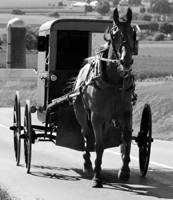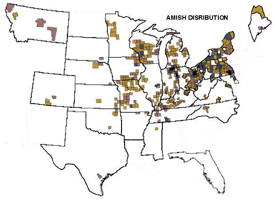
|
The Society of Folk Dance Historians (SFDH)
Amish
[
Home |
About |
Encyclopedia | CLICK AN IMAGE TO ENLARGE |

|
 Amidst the highly industrialized, mechanized, and scientific society in which we live, there exists a group of people who have chosen to live within a fixed and almost static social structure. These people, called Mennonites, place a premium on stability rather than change or progress, seemingly ignoring fads, social status, worldly stresses, and allurement.
Amidst the highly industrialized, mechanized, and scientific society in which we live, there exists a group of people who have chosen to live within a fixed and almost static social structure. These people, called Mennonites, place a premium on stability rather than change or progress, seemingly ignoring fads, social status, worldly stresses, and allurement.
In reality, fads, social status, worldly stresses, and allurement do exist and have caused schisms, dissension, and separation in Mennonite congregations. For example, in Wayne County, Ohio alone, it is possible to distinguish at least twelve separate grous of Mennonites that formed, each identified by its degree of adjustments to the modern world: Old Order Amish, New Amish, Beachy Amish, Mennonites, Conservative Mennonites, Church of God in Christ, Old Mennonites, Old Order Wisler Mennonites, Middle District Conference, General Conference, Apostolic Christian, Reformed Mennonites, and Oak Grove Mennonites.
The grouping is only momentarily accurate, because new alignments develop constantly. For instance, among the Old Order Amish there now exists the larger Schwarzentruber group and the smaller Stutzman and King offshoots. They differ regarding certain aspects of their appearance such as the cut of their hair, the size of the brim of their hat, and/or the use of a glass window in the side of their buggy. These items are considered essential to salvation itself – and association with people who see things differently is forbidden.
In general, the Old Order Amish wants are their needs, and their needs are their everyday basic requirements for living. Their mode of transportation is the horse-drawn carriage. Next year's model will have the same style as last year's model. If they take care of the carriage they acquire after marriage, it will probably last them till death. Amish clothing style is dictated by the Ordnung (code of church discipline), and so, styles never change. Most of their clothing is hand made by the women during the long cold winter evenings. Men wear black suits with no buttons, just hooks and eyes. Their shirts can be colored, but designs or prints are not allowed, and neckties and bowties are taboo. A broad-brimmed straw hat is worn in the summer, and a black felt hat in winter. Married women wear black bonnets and black or dark-colored full-length dresses. Unmarried women wear white aprons, changing to black after marriage. Women must cover their heads at all times. The outsider can readily see these aspects of Amish life.
A more intimate glimpse into Amish life is revealed when you look at the Amish barn and how it fits as the center stage of the society. These grandiose structures, often with a width of 50 feet and length of 114 feet, are so wide that a team pulling a harvest wagon is able to turn around inside. They are two-story, multi-purpose buildings with a forebay or overshoot (a second story extension over the front wall), a unique feature of these barns. Many are banked on one side at the upper level to permit the entry and exit of hay wagons.
The barn houses livestock on the bottom level, while the top level is used for threshing grain and storing grain, hay, and straw. The second floor, with its characteristic overshoot, provides the animals in the barnyard with a shelter against rain and sunshine. The barn also serves as a church, accommodating a whole congregation for the lengthy bi-weekly Sunday observance.
The Old Order Amish hold their church meetings at the homes of the members, gathering in one or another of the large banked barns. The rounds are arranged so that each family of the district hosts a meeting once a year. Sets of plain wooden benches are placed in long rows in the threshing den of the upper story of the barn where the worshipers sit in groups separated by sex and age. Men and women face each other while the leaders of the service and visiting preachers sit around a table at the far end. At the conclusion of the formal religious service, two benches are moved together and covered with a white tablecloth to make a table for the communal meal provided by the hosts. Here, too, men and women sit on opposite sides.
After eating, the parents leave and the young folks stay for general merrymaking. Since the young have not yet become official church members, their frolicking is relatively unrestricted – there are no curfews and no chaperones. One Amish man expressed the philosophy behind these "frolics" by saying, "The young folks need to work off steam, and it is better that they do it while they are young than they should do it after they have joined the church and are married."
When summer is over and most of the crops have been harvested, the new season brings a chance for the Amish to relax and enjoy pleasant times with friends and neighbors. All the wagons and farm equipment are moved out of the barn, lanterns are hung from rafters, and boards set up on barrels to provide suitable serving space for refreshments. Thus setting the stage for a Barn Dance (or Hoe Down as it is sometimes called).
When the musicians strike up familiar tunes, there is a sudden burst of rhythmic activity as the sturdy young people throw themselves into dancing with the same vigor and determination they express in their farm labors. Here they sing and dance to the so-called "fast tunes" of mountain or cowboy music, with names such as Old Joe Clark, Arkansas Traveler, Orange Blossom Special, Mississippi Sawyer, Ragtime Annie, Rubber Dolly, Chinese Breakdown, and Irish Washer Woman. Such frolicking, however, stops with marriage. While these young people are still unbaptized and outside the church, they arre allowed forms of behavior that ould not be tolerated in church members.
During these "frolics," the young men begin to cast their eyes out for suitable young women. When a young man decides on one whom he would like to accompany home, he finds a friend to intecede with the young woman on his behalf. It is considered unbecoming for a young suitor to ask personally or take a direct approach in those first contacts.
The Amish wedding season lasts from early fall until late winter. The age at which the Amish marries seems to vary. In 1950, in Mifflin County, Pennsylvania, the mean age for Amish women was 22.3 years and for men it was 24.2 years. There are no weddings during leap year.
The marriage festival, the most joyous social event of the year, takes place in the bride's barn on either a Tuesday or Thursday. The wedding party and guests easily numbers three or four hundred people – all relatives and friends, mostly of the bride. The ceremony is always held in a different barn than that in which the guests are entertained at dinner. The religious service compares with a regular Amish district meeting. Joining of hands by the highest authority in the community, the bishop, is the official marriage act. His prayer and blessing mark the culmination of the marriage ceremony. The Old Order Amish church does not issue certificates and keeps no records of marriage. Until recently, members of the sect did not even record their marriage in the county courthouse.
The bride and groom do not go on a honeymoon. As a matter of fact, they do not live together until they set up housekeeping the following spring. After the wedding, the bride and groom begin weekend visitation tours of all the adult relatives that attended the wedding. Every Friday evening, the groom picks up his bride from her home and they make their first visit of the weekend. They will stay for the night, have breakfast the following morning, and leave. They then visit the next family where they have supper. After supper, they leave to visit another family where they spend the night, and breakfast on Sunday morning. The following Friday, the visitation will repeat itself, with the couple visiting with different hosts. By spring, the tours will have included all the relatives, so the bride and groom can begin their housekeeping.
Perhaps the most spectacular of the Amish community's projects is the occasion known as a "Barn Raising." A farmer and his sons build the barn's foundation and prepare timbers. Then they invite their neighbors to help them raise the barn. The phrase, "Raise the Barn," has come to include the communal building of any structure, such as a home, workshop, or storage shed.
The following account in the "Budget," an Amish newspaper in Sugarcreek, Tuscarawas County, Ohio, is enlightening:
"569 volunteer helpers gathered at the barn raising on the Milo Miller farm one mile south of Walnut Creek [Holmes County, Ohio], last Thursday morning, and when evening came a brand new barn stood on the Miller's foundation. The new barn, a two-story 50x74 foot building with 13 stanchions, three horse and four box stalls, an inside watering trough and two hay mows, was completely erected in one day. Only the basement, built of glazed tile with a concrete floor, and the foundation was completed beforehand. Members of three churches – the Evangelical and Reformed, Amish and Walnut Creek Mennonite – took part in the barn raising. At five o'clock in the morning the Highways in all directions were filled with horses and buggies going to Miller's farm. In all, two hundred and eight horses were tied at the farm. At noon there was a pause as the five hundred and sixty-nine men lined up at the food tent to partake of the bountiful lunch which one hundred and sixty-nine women prepared."
This article touches on some of the traditions of the many subgroups of the Mennonites that came to this country from Germany in the 1500s – a group that brought a 16th century German peasant tradition that they have been able to maintain to a surprising degree in the New World. For more detailed information, refer to some of the books listed in the following Bibliography.
BIBLIOGRAPHY
- Bendix, Regina. The Quest for Authenticity in Tourism and Folklife Studies. Pennsylvania Folklife, 1993-94; 43(2):67-71.
- Brandt, Mindy and Gallagher, Thomas E. Tourism and the Old Order Amish. Pennsylvania Folklife 1993-94; 43(2):71-76.
- Rice, Charles S. and Steinmetz, Rollin C. The Amish Year. Rutgers University Press, New Brunswick. 1956.
- Schreiber, William I. Our Amish Neighbors. University of Chicago Press, Chicago. 1962
- Smith, Edward C. and van Horn Thompson, Virginia. Traditionally Pennsylvania Dutch. Hastings House, New York. 1947.
- Stoudt, John Joseph. Sunbonnets and Shoofly Pies. A Pennsylvania Dutch Cultural History. A.S. Barnes and Company, London. 1973.
- Warner, James A. The Gentle People: A Portrait of the Amish. Grossman Publishers, Inc., New York. 1969.
- Williams, Jean Kinney. The Amish. Franklin Watts, A Division of Grolier Publishing, New York. 1996.
Used with permission of an author.
Printed in Folk Dance Scene, February 1998.
This page © 2018 by Ron Houston.
Please do not copy any part of this page without including this copyright notice.
Please do not copy small portions out of context.
Please do not copy large portions without permission from Ron Houston.